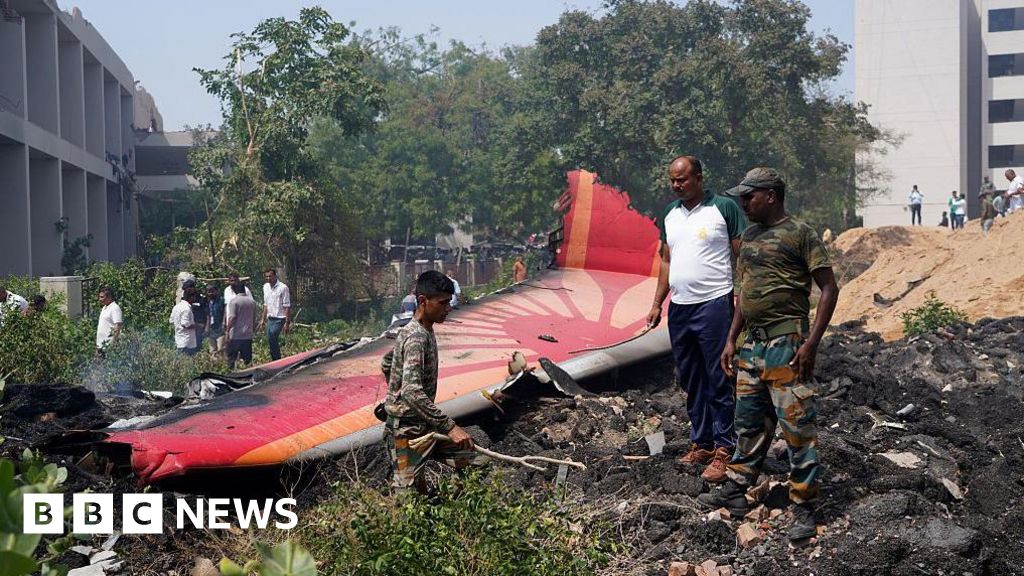Investigators have recovered flight recorder data from the Air India crash earlier this month, the civil aviation ministry has confirmed, marking a key step in the probe. At least 270 people were killed when the London-bound Boeing 787-8 Dreamliner crashed less than a minute after taking off on 12 June from Ahmedabad airport in western India. Investigators had earlier recovered both sets of Enhanced Airborne Flight Recorders (EAFRs) - the "black boxes" - from the Boeing 787 crash site on 13 and 16 June - one from a rooftop, the other from the debris. It could be several weeks before the federal government is able to release information gathered from the recorders. The particular aircraft model carries the two recorder sets to aid in thorough analysis. These combined units record flight data and cockpit audio. Data recorders track with high precision the position of gear and flap levers, thrust settings, engine performance, fuel flow and even fire handle activation. The data can be used to reconstruct the flight's final moments and determine the cause of the incident. The cockpit voice recorder (CVR) captures pilot radio calls, individual mic audio, and ambient cockpit sounds via an area microphone. The aviation ministry said data from the recorder was accessed on Wednesday by a team led by India's Aircraft Accident Investigation Bureau (AAIB), with the US National Transportation Safety Board (NTSB). "The analysis of CVR and FDR [flight data recorder] data is underway. These efforts aim to reconstruct the sequence of events leading to the accident and identify contributing factors to enhance aviation safety and prevent future occurrences," the ministry said in a statement. Meanwhile, US National Transportation Safety Board chair Jennifer Homendy told Reuters news agency that she hopes the Indian government will be able to share details from the investigation into the crash in short order. "For aviation safety and for public safety and public awareness we hope that they will make their findings public swiftly," Homendy said on the sidelines of an aviation event. She said the NTSB team has been working diligently to provide assistance to India and "we have had excellent cooperation from the Indian government and the AAIB." India's decision to download and investigate data from the flight recorders comes nearly two weeks after the crash and has raised questions among aviation experts, some of whom described the delay as unusual. Air India Flight 171 was airborne for less than 40 seconds before it crashed into a crowded Ahmedabad neighbourhood, killing all but one of the 242 passengers on board, in one of India's most puzzling air disasters in recent memory. The London-bound Boeing 787, piloted by Captain Sumeet Sabharwal and co-pilot Clive Kundar, took off at 13:39 local time, but issued a mayday call moments later - its final transmission.
India recovers data from crashed Air India flight recorders
TruthLens AI Suggested Headline:
"Investigators Recover Flight Recorder Data from Air India Crash"
TruthLens AI Summary
Investigators have confirmed the recovery of data from the flight recorders of the Air India crash that occurred earlier this month, a significant development in the ongoing investigation. The tragic incident resulted in the loss of at least 270 lives when the Boeing 787-8 Dreamliner, bound for London, crashed shortly after takeoff from Ahmedabad airport on June 12. The Enhanced Airborne Flight Recorders, commonly referred to as 'black boxes', were retrieved from the crash site on June 13 and June 16, with one found on a rooftop and the other among the wreckage. The aircraft's design incorporates two sets of recorders which are essential for a thorough investigation, as they capture crucial flight data and cockpit audio. The data recorded includes vital information such as the position of flight controls, thrust settings, engine performance, fuel flow, and even the activation of fire handles. This comprehensive data is instrumental in reconstructing the events leading up to the crash, allowing investigators to ascertain the cause of the incident and implement safety measures to prevent future occurrences.
The analysis of the cockpit voice recorder (CVR) and flight data recorder (FDR) is currently underway, led by the Aircraft Accident Investigation Bureau (AAIB) of India alongside the US National Transportation Safety Board (NTSB). The aviation ministry has indicated that it may take several weeks before any findings from the recorders can be released to the public. NTSB chair Jennifer Homendy expressed the hope that the Indian government would share details of the investigation promptly, emphasizing the importance of transparency for aviation safety and public awareness. The crash, which occurred less than one minute after takeoff, has raised questions about the delay in data recovery and analysis, as experts noted that such delays are unusual. Air India Flight 171, piloted by Captain Sumeet Sabharwal and co-pilot Clive Kundar, made a mayday call shortly before its final transmission, adding to the mystery surrounding this devastating aviation disaster.
TruthLens AI Analysis
You need to be a member to generate the AI analysis for this article.
Log In to Generate AnalysisNot a member yet? Register for free.
